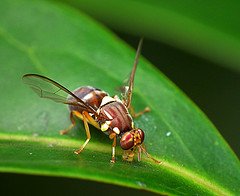Containment at early stages is critical, say experts commenting on the detection of Queensland fruit flies in Auckland.

The flies, which pose a threat to export fruit and vegetable markets, were first detected in a surveillance trap last week. The Ministry for Primary Industries (MPI) has put in place a restriction zone, limiting the movement of fresh fruit and vegetables in the area.
Yesterday MPI confirmed it had discovered a fourth fruit fly in the area. More information on the Queensland fruit fly is available on the MPI website.
The Science Media Centre collected the following expert commentary. Feel free to use these quotes in your reporting. If you would like to contact a New Zealand expert, please contact the SMC (04 499 5476; smc@sciencemediacentre.co.nz).
Dr Richard Newcomb, Chief Scientist, Plant & Food Research, comments:
“The Queensland Fruit Fly is a serious potential pest of New Zealand horticultural crops. Found in Australia and New Caledonia, New Zealand operates a strict biosecurity fence to mitigate the risk of establishment of the pest.
“At Plant & Food Research we have high expectations that the current incursion will be controlled. Typically, incursions of fruit flies are eradicated, with the success rate currently running at 93% from a total of 198 eradication programmes against fruit flies worldwide.
“For the Queensland Fruit Fly 25 incursions have been eradicated. As well as a suite of monitoring and control tools, eradication is aided by the facts that substantial numbers are required to initiate a sustaining population and some peculiar mating behaviour that involves males congregating to attract females. So while the fly is a good traveller it is not always a great coloniser.
“Plant & Food Research is involved in a number of collaborative research programmes on insect biosecurity in New Zealand and Australia focused on identifying biosecurity risks and their potential pathways of entry, as well as the development of tools for diagnostics, surveillance, and eradication. Some of this research includes specific projects on the monitoring and control of Queensland Fruit Fly.”
Associate Professor Phil Taylor, Department of Biological Sciences, Macquarie University, comments:
“These flies pose a significant threat to New Zealand horticulture because they have an extremely wide host range, being able to infest and reproduce in a wide diversity of fruit and vegetable – both commercial and backyard. If established they would be very costly to contain, and would make New Zealand produce less attractive to overseas markets.
“Affected produce includes some of New Zealand’s major crops, such as apples, pears, kiwifruit, grapes, peaches, nectarines, cherries, strawberries and apricots. Also many kiwi backyard favourites.
“A population could be quite easily established, especially in warmer areas in the north of New Zealand where they might have suitable hosts available year around. One of the greatest fears now is that a population might not just establish, but might also spread to other locations. Containment at these early stages is critical.
“Options for control include tight restrictions on the transport of host fruit and vegetables, use of toxic fruit fly baits, and local use of insecticides where required. While unlikely to be needed for the current outbreak, the release of sterile flies that disrupt the reproduction of wild populations is also an option.”
Professor Anthony Clarke, Chair of Fruit Fly Biology and Management, Queensland University of Technology, comments:
“Queensland fruit fly, an Australian native species, attacks a very large range of horticultural fruits and vegetables. The fly lays its eggs into fruit, where the maggots feed. Queensland fruit fly is Australia’s number one horticultural insect pest and it has the potential to destroy unmanaged crops and orchards. New Zealand does not have this species, nor indeed any other species of fruit infesting fruit fly.
“This gives New Zealand horticultural produces significant benefits. Firstly, they can grow their produce without risk of fruit attack. Secondly, as fruit flies as very significant quarantine threats, New Zealand produce can gain easier access to international markets without the need for expensive post-harvest disinfestation procedures.
“Potentially all fruit and fleshy vegetables are at risk to Queensland fruit fly. Each fruit and variety of fruit needs to studied on a case-by-case basis, but the fly does have a very broad host range.”
“Population establishment is relatively easy if the fly is not actively controlled, but with prompt action eradication of a small Queensland fruit fly population is technically relatively easy. New Zealand biosecurity authorities have a highly intensive trapping network to detect fruit flies when they first enter New Zealand. Coupled with a very well developed response program, New Zealand is probably the best equipped nation in the world to detect and eradicate a fruit fly incursion. The detection of single, or very low numbers flies in New Zealand, should be seen as a sign that the system is working. I am very confident they will eradicate this incursion promptly.”
“Current options for combating fruit fly incursions include:
- Baiting for male and female fruit flies using poisoned protein baits
- Baiting for male fruit flies using poisoned male-specific lures
- Door knocking to source back-yard fruit trees and destroying infested fruit
- Stopping the spread of fruit.”